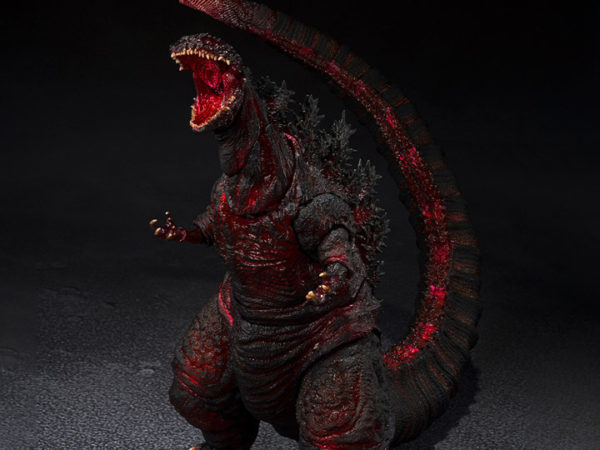
When it comes to giant monsters, few stand the test of time as well as Toho’s own kaiju icon, Godzilla, who has gone off to destroy monsters in a franchise spanning 38 films and other media. Most people when they see Godzilla, think of him in an action movie sense where they are rooting for him against whatever monster threat he may be facing, be that Mothra, Mecha-Godzilla, Kong, King Ghidorah, or something else, but Godzilla was never originally created to be a monster for audiences to root for. Within the original 1954 film, Gojira, Godzilla was depicted as a force of destruction attacking Japan, a metaphorical reliving of the nuclear trauma the country faced at the end of World War 2. Given the black and white aesthetic, dark tone, and depiction of people’s lives ruined by Godzilla’s destruction, the film was a horror story with a monster to be afraid of. Shortly after that, Godzilla fell quickly into being a series about monster action rather than horror, but 62 years after the original film, Shin Godzilla released and showcased to the world a new rendition of the classic monster. With a burnt skin design and ever evolving abilities, Shin Godzilla brought Godzilla back to his horrifying roots as a destructive symbol of nuclear power, but the film also gave him a new Lovecraftian sense of dread as Japan’s government begins to unravel what Godzilla is and attempt to stop him before he can become a threat to all of humanity.
What does it mean to be Lovecraftian?
The term “Lovecraftian” gets thrown around a lot in horror discussions and most often it is either thrown in the direction of anything with too many tentacles or a literal adaptation of an H.P. Lovecraft story, but Lovecraftian horror is often interchangeable with cosmic horror in the sense that it is horror elicited from concepts or beings that are so much greater than humanity and our understanding that it is impossible to truly ever stop or comprehend them. The best hope within these stories are for the characters to either delay the inevitable or just manage to survive, and that is the best case scenario if the book, film, or game hopes to maintain that atmospheric feeling of dread that this type of horror elicits. In order to be Lovecraftian, the horror needs to be unexplainable and unstoppable.
The Initial Emergence
Shin Godzilla, directed by Hideaki Anno, doesn’t delay before dropping audiences into the deep end as a strange steam eruption happens just outside Tokyo which destroys a highway. Political figures rush to find an answer for the strange eruption as well as calm the public, but the bureaucracy of the government lands the politicians in endless meetings without any solid solutions. When the main character, Yaguchi (Hiroki Hasegawa), discovers an internet video of a tail emerging from the eruption and brings it up with his colleagues, he is scoffed at until Godzilla makes his first on-screen appearance. Swimming through a river that flows through Tokyo, Godzilla creates a small path of destruction leaving the Japanese government baffled, until he makes landfall, where audiences are greeted with the second form or first fully visible form of the new redesign of the classic monster: a short house-sized creature that is shaped like an eel with lifeless eyes and blood flowing from its gills.
Fans of the franchise were no doubt surprised by this initial depiction of Godzilla, who was hardly the towering icon of destruction they were used to. This second form of Godzilla stumbles through the streets of Tokyo like a scared animal as Japan rushes its military to deal with him. In scenes prior to Godzilla’s emergence onto land, politicians and biologists analyze the creature to the best they can and fully expect Godzilla to collapse under his own weight, but in an act of defiance to what humanity knows, Godzilla stumbles onto land spreading his path of destruction deeper into Tokyo. Helicopters deploy to stop Godzilla, but they are met with something they couldn’t have predicted.
A New Evolving Threat
Godzilla has many forms within Shin Godzilla. So, when the choppers arrive to deal with Godzilla, they are greeted with him mutating into a bipedal reptile that stands upright with hardened skin. The characters of the film are shocked by Godzilla’s apparent mutating abilities, but Godzilla quickly flees in order to return to the ocean as his body overheats due to the energy required to evolve. At this point in the film, audiences have experienced a lot of unknowns with these new changes to the character of Godzilla, and with the element of the unknown being added to the film, a feeling of suspense is able to build up for audiences as they know Godzilla will return and could evolve into anything.
After the discovery of Godzilla’s evolving abilities, a small team of scientists and experts form. They research what they can on Godzilla’s capabilities and brainstorm ways to stop him. Through the destruction in Godzilla’s first attack, they learn he leaves behind radiation which leads the characters to believe Godzilla is a living nuclear reactor capable of fission in order to mutate itself to survive anything. Worries begin to pop up on the idea that Godzilla may be immortal, but their worries only worsen as Godzilla returns, now in his iconic form.

Who Will Know (Tragedy)
Evolving into his fourth form, Godzilla now stands at his mountainous dinosaur size and attacks Tokyo again, destroying everything in his path. The military deploys and fires upon Godzilla with everything they have, but nothing leaves a scratch. Godzilla has mutated to be able to endure most what the Japanese military can use, even going so far as to shield his eyes with metallic-like eyelids when bombs detonate too close. A sense of awe and terror forms as Godzilla effortlessly strolls through Tokyo as if humanity is nothing to him. He is apparently unstoppable until the U.S. intervenes.
U.S. bombers fire on Godzilla directly in his spine, causing the monster to bleed. Hope flashes onto the characters’ faces only to be immediately snuffed out as Godzilla charges up his atomic breath. Godzilla leans forward and “vomits” up a sea of black smoke that floods the streets of Tokyo only to ignite it, engulfing the entire city in a bed of fire. Godzilla focuses the atomic breath into a laser-like purple beam that cuts through buildings and aims into the sky with marksman-like aim to destroy a bomber. Remaining U.S. bombers continue their assault with another bombing run, but Godzilla showcases a new ability by lighting up his spine and unleashing a flurry of laser beams that destroys both the bombs and bombers, shattering any preconceived notions of Godzilla. All forces are dead and Godzilla turns his rampage back on the city by destroying everything.
Godzilla stands over the ruins of a city as a glowing figure among raging fires. This imagery lingers before audiences as the song Who Will Know (Tragedy) by Shiro Sagisu plays, engulfing all audio. In what is the most impactful scene of the film, audiences are left with the unstoppable and incomprehensible destruction in Godzilla’s wake as the melancholic music sets the mood for somber reflection. Troops, tanks, choppers, artillery, and bombers, the might of humanity’s military seemingly didn’t leave a single impactful scratch on Godzilla’s armored skin. This display of horror showcases how weak humanity is to the power of Godzilla, and his destruction only halts because Godzilla goes into a temporary hibernation after using so much energy. This temporary halt gives humanity a brief moment to breathe.
A Nihilistic Reflection
Often with stories involving Lovecraftian existential threats to humanity, there is an underlying nihilistic feeling to the events. With the temporary moment to breathe and reflect after Godzilla destroys Tokyo, the team of scientists and experts reconvene in order to hatch a plan to freeze Godzilla with a blood coagulant so that they can prevent the use of a nuclear weapon against Godzilla, which is sanctioned by the UN. In their desperate research they discover a dorsal fin was actually dismembered in the battle in Tokyo. With such a large sample of Godzilla’s DNA, they learn that Godzilla is capable of outright duplicating itself and evolve to have wings, which would allow his destruction to spread globally, affecting all of humanity. Right then it is confirmed for the characters and audiences, Godzilla is a walking apocalypse that can wipe out humanity if given the time.
Godzilla has always been a force of destruction that can affect all of humanity if he wanted to, but he was never depicted as anything beyond a very powerful animal lashing out against humanity, even in the original horrifying film, but in Shin Godzilla audiences are shown a monster that is more than just an animal. The film depicts a furious being that is capable of evolving to survive anything humanity can throw at him. In Gojira, humanity is able to develop a device to outright kill Godzilla. In most of the solo outings involving Godzilla, humanity without a doubt overcomes the challenge and defeats Godzilla, but as Shin Godzilla progresses, the plan involving the blood coagulant succeeds in freezing Godzilla, only temporarily stopping the monster. There is a moment of resolution where the characters cheer and breathe easily, having survived Godzilla and prevented the need of the nuclear launch ordered by the UN, but all the uplifting moments in the final minutes of the film are filtered through a sense of “for now.” Godzilla is stopped… for now. The nuclear launch is stopped… for now. Yaguchi, the protagonist, looks out at the frozen Godzilla without a true satisfying sense of victory. He looks at Godzilla, aware that he will wake up again, dreading the inevitable destruction.
The Dreadful Threat Still Looms
Lovecraftian horror stories, or anything that remotely tips into that type of existential subject includes a scene where characters and audiences are left with the threat that still looms large (presuming the threat doesn’t outright win). A massive feeling of dread is necessary in these kinds of stories and in the final scene of Shin Godzilla, the camera lingers over the frozen Godzilla and ends on his tail as humanoid monsters reach out of his flesh, frozen in a position that showcases the little creatures crying out in agony and wanting to break free. This last shot suggests Godzilla evolving into a fifth form in order to further survive humanity’s attack. Incorporating aspects of humanity and potentially multiplying in numbers, audiences are left with a dreadful suggestion of what Godzilla plans to do. There are no answers, only unknowns as the film ends with a clock ticking down to when Godzilla awakens again to unleash his incomprehensible destructive might.
The God Incarnate
Godzilla throughout history has been depicted a prehistoric dinosaur, humanity’s savior, an anti-hero, and even a vengeful spirit, but within Shin Godzilla, Godzilla is depicted as an ever-changing threat that trumps humanity’s ability to understand him, let alone defeat him. Lovecraftian entities are often perceived as gods to human characters as they stand in awe and horror at the threat they pose, and throughout Shin Godzilla, multiple characters refer to the classic monster as a god-like being as he continues to easily overcome anything humanity throws his way. With a radioactively scarred appearance and the ability to evolve and mutate in ways audiences have never seen before, Godzilla steps into the realm of Lovecraftian horror as the politicians and scientists struggle to keep up with him, and instead of a happy resolution where humanity can move on, humanity is left with only a brief moment of relief as the dread of the disastrous monster reawakening lingers on. Just as many characters refer to him within the film, Godzilla is god incarnate.
[via]




